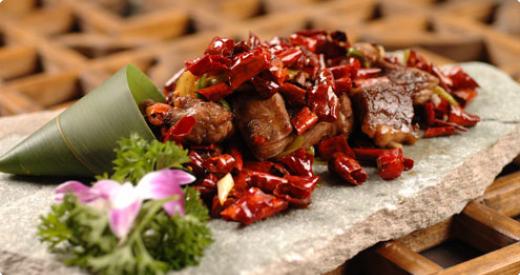Some Like It Ma La: Sichuan Spice

Imagine yourself sitting at a table with a bubbling hotpot of fragrant soup steaming in front of you. Clusters of chilli float on a thick surface of chilli oil mixed with hua jiao peppercorns from the western Chinese mountains of Sichuan. Take a sip and you begin to notice, beyond the initial shock of intense heat, the flavours falling away to a subtle lingering aroma that just teases the palate. While Sichuan food is distinctively famous for its spicy character, the word “spicy” is somewhat inadequate to describe the nuanced layering of flavours, spices and peppers. The balance of chilli peppers and hua jiao is a special art in Chengdu—creating a pleasant mouth-numbing experience ( ma ) and at the same time stimulating the palate ( la ).
Spicy cuisine has a long history in western China. The use of dried daylily buds and the local Sichuan hua jiao peppercorn have been mentioned in the Songs of the South, a poetry collection written in the ancient state of Chu (1030-223BC). However, the chilli pepper that now pervades Chengdu’s most colourful signature dishes—from mapo tofu to kungpao chicken—is actually non-indigenous to China and was only introduced from the New World during the 17th century. There are many theories on how the foreign pepper came to this land-locked, mountainous province; some posit that Marco Polo brought the ingredient to China during his travels while others credit the Indian missionaries trading along the Silk Road.
Today, chillies and hua jiao are a signature of Sichuan cuisine. The “facing-heaven” chao tian pepper is one of the most common types—a plump, bright red specimen roughly the size and shape of a chicken heart. They are generally sweeter than the long and thin er jin tiao , which tend to be milder in spiciness. Both are used in a variety of ways: fresh, dried, pickled or processed into chilli oil. The chilli oils are often infused with aromatics such as cloves, cassia bark or star anise. Er jin tiao are also fermented with broad beans to create the well known Sichuan dou ban jiang or chilli bean paste. These pastes can be used fresh, but will take on more complex characteristics as they mature and darken in colour over time.
To make mapo tofu, dou ban jiang chilli bean paste is first sizzled in oil on high heat to achieve a crimson colour and rich fragrance before minced pork, garlic and scallions are then tossed in with chilli oil, chilli flakes and tender chunks of tofu. The famous kungpao chicken is a traditional dish made with chicken pieces, peanuts, leeks and dried chillies. Lazi “thousand chilli” chicken is a good example of the Sichuan method, crisp frying bite-sized nuggets of chicken with whole chao tian peppers, er jin tiao and hua jiao . This dish showcases the multi-layered complexity of Sichuan spices—from the citrusy, medicinal aroma of hua jiao to the sweet bite of chao tian pepper.
The distinctive ma la heat is one of the essential aspects of Sichuan cuisine. The flavour comes from the floral hua jiao which lends that unique, tongue-tingling spiciness. The finest hua jiao are grown in Hanyuan country in the western mountains of Sichuan. These Chinese peppercorns are used whole in Sichuan pepper oil or dry-roasted and ground into powder. Ground hua jiao is quite versatile—by itself, as a complement to chilli in ma la dishes, mixed with salt as a common table condiment or combined with star anise, cloves, cinnamon and ground fennel seeds to make five spice powder.
The flavours of Sichuan cuisine are diverse beyond what can be described in the monochromatic catchall “hot and spicy.” The boldness of the spices and the chilli peppers belie the sophistication of the cuisine which is highly nuanced in balancing taste, piquancy, textures and aroma. This variety is what makes Sichuan such a popular regional style and continues to win over gourmands worldwide.









